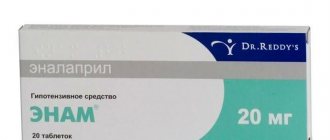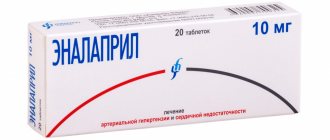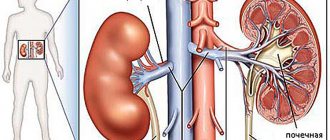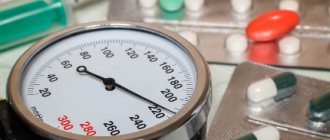Essential arterial hypertension is an increase in systolic blood pressure at the time of heart contraction and blood ejection to 140 mmHg. Art. and above this mark and/or diastolic blood pressure at the moment of relaxation of the heart muscle to 90 mmHg. Art. and higher.
The Yusupov Hospital diagnoses and treats essential hypertension. The experience of highly qualified doctors and modern medical equipment make it possible to diagnose the disease at an early stage of its development and prevent complications.
Doctors at the Yusupov Hospital urge people to be attentive to their health.
Essential hypertension - what is it?
Essential hypertension is a form of arterial hypertension (AH), characterized by a stable increase in blood pressure (from 140/90 mm Hg and above) in the absence of pathological changes in the organs and systems that regulate it.
Essential hypertension accounts for approximately 90% of the total number of cases of arterial hypertension.
Every year, about 9 million cases of this form of hypertension are reported worldwide, with a mortality rate of 6.5%.
Prevention
In the absence of a genetic predisposition, the occurrence of essential hypertension can be prevented. To reduce the risk of developing hypertension, doctors recommend adhering to the following rules:
- dose physical activity;
- avoid stressful situations and respond adequately to what is happening;
- lifestyle changes;
- normalize your diet;
- Use medications only as prescribed by a doctor.
Doctors recommend periodically measuring blood pressure, which will allow timely detection of the problem. Walking in the fresh air, the daily duration of which should be at least 1.5 hours, is considered a good prevention of the disease. If there is a slight deviation of pressure readings from the norm, jogging at a slow pace is acceptable; gymnastics and yoga have a good effect of improving well-being.
Etiology of the disease
Essential hypertension is classified as a chronic disease of unknown etiology. It is generally accepted that the main factor in the development of the disease is hereditary predisposition.
There are also additional risk factors:
- Insufficient physical activity. With physical inactivity, the functional and adaptive capabilities of the circulatory system are reduced.
- Excess weight. Obese people have a tendency to spasm blood vessels and narrow their lumen due to cholesterol deposits.
- Excessive salt intake. An adult needs only 4 grams of salt per day, but the average European resident consumes about 3 times more than this amount. Excess salt causes increased production of adrenaline and vasospasm.
- Lack of magnesium and calcium. These microelements prevent spasm of the heart muscle and blood vessels, thereby stabilizing blood pressure (BP).
- Alcohol consumption. If you do not exceed the recommended dose (that is, approximately 60 grams of alcoholic drinks with a strength of 40% for men and 40 grams for women), alcohol does not cause an increase in blood pressure. Exceeding this dose will lead to an increased release of norepinephrine and renin into the blood, due to which the pressure will begin to rise rapidly.
- Smoking. The effect of nicotine on the functioning of the cardiovascular system is in many ways similar to the effect of alcohol: it provokes the production of adrenaline and norepinephrine, which cause vasospasm, which in turn causes an increase in blood pressure.
- Age. As the body ages, the functional state of the systems that regulate normal blood pressure levels deteriorates.
Often the trigger for exacerbation is a stressful situation, which provokes the release of adrenaline and norepinephrine. That is why people who regularly experience nervous tension are more often predisposed to essential hypertension than others.
Other trigger mechanisms are also possible:
- poisoning;
- taking psychostimulants;
- use of hormonal contraceptives;
- pregnancy;
- kidney diseases;
- injuries, tumors and inflammatory diseases of the brain.
Symptoms of the disease
The manifestations of essential hypertension have much in common with other diseases of the cardiovascular system. In addition to persistently elevated blood pressure, the following symptoms are distinguished:
- Headache (mainly in the temporal and occipital region).
- Rapid heartbeat (over 90 beats per minute).
- Dyspnea. Usually occurs as a consequence of deterioration in the functional capacity of the heart, which can lead to deterioration of blood supply to the brain and lungs.
- Feeling of coldness in the extremities. This condition is caused by impaired peripheral blood supply.
- Dizziness. Due to vascular spasm, the brain does not receive enough oxygen.
- Swelling of the limbs. They arise due to thinning of blood vessels, which leads to the accumulation of fluid in the tissues.
- Deterioration of vision. They arise due to impaired blood supply to the retina.
- Noise in ears. Occurs due to impaired blood supply to the brain.
- Fast fatiguability. It occurs as a result of a decrease in the functional capacity of the heart.
- Facial redness. Caused by increased tone of peripheral blood vessels.
When to see a doctor
None of the above symptoms should be ignored. If the pressure readings approach 180/110, you should call an ambulance. If even a slight increase in blood pressure is observed over the course of several days, you should make an appointment with a therapist or cardiologist.
Formally, the upper limit of normal is considered to be a blood pressure of 140/90, but it is important to understand that these are rather arbitrary figures. For example, some patients do not feel discomfort even at 150/100, while for others 135/85 causes a significant deterioration in well-being. Therefore, it is important to focus primarily on your own condition.
Figure 1. How to protect yourself from hypertension. Source: MedPortal
Stages and causes of hypertension development
The classification of the stages of development of essential hypertension is based on the criterion of the boundaries of pressure indicators. In total, it is customary to distinguish 3 types, each of which has its own symptoms and the nature of its effect on the human body.
The latter is characterized by very high blood pressure levels, which is accompanied by negative pathological disturbances in the functioning of vital systems and a decrease in the effect of medications.
The degree of violations that have occurred is determined by measuring indicators; the number of recorded cases is of great importance. What is important is not the one-time fact of recording a deviation from the norm, but the repetition of the event 3 or 4 times a month.
Primary
Primary essential hypertension occurs in 90% of people and is often detected during a medical examination. It is characterized by a slight excess of the following indicators:
- upper no more than 159;
- the bottom ranges from 90 to 99.
With a slight deviation from the norm, the patient does not feel much discomfort and for a long period may not be aware of the occurrence of a problem. The diagnosis is made based on the tonometer points. The first stage is associated with a high risk of various complications due to diabetes or problems with the functioning of internal organs. The high-risk group includes patients with a history of ischemic attacks or a stroke.
Second stage
The stage of progressive hypertension is characterized by a significant increase in blood pressure. Diagnosis criteria:
- upper 160-179;
- lower 100-109.
At stage 2, changes in the vascular walls are diagnosed and signs of hypertrophic changes in the myocardium appear. Such changes are not capable of significantly affecting the condition and functioning of internal organs. If self-treatment is attempted or there is no timely treatment, a person’s condition may worsen, and the disease may progress to the final stage, which is dangerous to health.
Third stage
The stage is considered the most severe, and the indicators are 180/110 or higher. Due to the risk of pathological changes, it is often called the “stage of organ change,” since with a high blood pressure value, pathological changes in the structure of blood vessels and organs are clearly visible. The totality of the nature of the lesion and existing risk factors determines the likelihood of complications.
Target organs for essential hypertension
This definition is usually understood to mean those organs that are most susceptible to the negative effects of the disease (in this case, persistently elevated blood pressure). Target organs for essential hypertension:
- Heart. With increased load on this organ, hypertrophy of the left ventricle occurs. This creates the preconditions for insufficient oxygen supply to the myocardium, which can lead to the development of heart failure.
- Kidneys. Impairments in blood flow and glomerular filtration can eventually lead to renal failure, a syndrome in which the functional state of the kidneys significantly deteriorates. Over time, they may stop removing waste products normally, so it is important to start treatment on time.
- Vessels. Due to constant tension, they lose the ability to relax, which can lead to atherosclerosis of the arteries and peripheral vessels. A feeling of coldness in the extremities with high blood pressure occurs precisely for this reason.
- Brain. Stroke is a common complication of essential hypertension. They can be either hemorrhagic (bleeding in the brain) or ischemic (local disruption of the blood supply to the brain, leading to the death of its cells).
- Eyes. Impaired blood supply to the retina can lead to irreversible visual impairment, so the sooner treatment is started, the better the prognosis.
Clinical manifestations
The symptom complex of primary hypertension is caused by damage to target organs: heart, blood vessels, kidneys, brain. For a long time, hypertension is asymptomatic; special diagnostic methods are needed to detect it. The risk of death and the choice of therapeutic tactics depend on the underlying cause.
First (initial) stage
This is a clinical latent period. The only signs can be considered weakness, migraine, and increased blood pressure. Symptoms of essential hypertension appear with severe overexertion, physical activity, overeating, excessive consumption of coffee and alcohol. Over time, stress on blood vessels leads to cardiac pathology.
Second (crisis) stage
Pain behind the chest
The possibility of developing a crisis is the danger of the second stage. It is important not to miss the first symptoms: high blood pressure, chest pain, migraine pain, fainting. This is a reason for the patient to contact a doctor, who prescribes an examination and complex antihypertensive therapy.
Third (severe) stage
It is characterized by high blood pressure, encephalopathy, memory impairment, dementia, cardiovascular failure, and kidney pathology. This leads to metabolic disorders, protein in the urine, and creatinine in the blood. Changes in organs are usually irreversible and require constant monitoring by a doctor, periodic hospitalization, and adjustments in treatment. At this stage, heart attacks, strokes, and coma often occur.
Metabolic syndrome is diagnosed if a combination of three of the following five factors is diagnosed:
- visceral-abdominal obesity;
- high fasting blood sugar;
- BP more than 130/85;
- reduction in the level of HDL cholesterol - cholesterol, high-density lipoproteins;
- high levels of TG (triglycerides) are an indicator of lipid metabolism disorders.
Metabolic syndrome determines the degree of risk of complications and the likelihood of death.
Diagnosis of hypertension
First of all, the patient himself should pay attention to the regularity of the appearance of symptoms associated with arterial hypertension and the level of increase in blood pressure. Results above 140/90 more than 3 times within 2 weeks should be cause for concern.
The doctor begins the diagnosis by collecting an anamnesis, that is, the history of the patient’s life and illness. As a rule, he clarifies the following points:
- Does the patient or his close relatives have kidney disease?
- How often does a person use pharmacological drugs (particular attention is paid to anti-inflammatory drugs, nasal sprays, contraceptives, antibiotics, hematopoietic drugs, as well as any psychostimulants).
- Does the patient have sudden episodes of muscle weakness, cramps, headaches, or paresthesia (nerve sensation such as tingling, burning, etc.)
After this, laboratory and hardware diagnostics are prescribed:
- Urine tests: general
- according to Nechiporenko
- according to Zimnitsky
- detection of free cortisol in daily urine.
- general
How to prevent disease
Prevention of essential hypertension is no less important than timely initiation of treatment. If the body is genetically prone to pathology, this will be more difficult to do, but taking into account epigenetic modifications, it is still possible to reduce the risk of developing EAH. To do this you need to do the following:
- moderate physical activity, try to walk daily or perform a set of simple exercises in the morning;
- beware of stress and conflict situations;
- eat right, introducing vitamins, protein, fiber into the diet;
- give up cigarettes, alcohol, and drugs;
- regularly measure blood pressure;
- Avoid significant excess body weight.
These simple rules will help you avoid early manifestations of hypertension. And even if it develops due to hereditary causes, its symptoms will be mild and easily treatable.
Many people have heard about the dangers of arterial hypertension - heart attacks and strokes, atherosclerosis, loss of vision and other serious consequences, but not everyone is in a hurry to go to the doctor if blood pressure increases. While monitoring blood pressure and maintaining it within normal limits, even with the help of medications, guarantees long life for the brain, nervous system, blood vessels, kidneys and heart. In order to prevent hypertension, you should not only regularly visit a doctor and get examined, but also avoid stress, chronic fatigue and eat right - then the disease will not be terrible.
Classification of hypertension by stages
The stage of arterial hypertension is determined based on the severity of symptoms and involvement of target organs.
First stage. Symptoms are mild and sometimes completely absent. As a rule, the onset of the disease is signaled only by a slight increase in blood pressure. There is no evidence of end-organ involvement.
Second stage. Symptoms characteristic of hypertension regularly occur, pathological changes in the blood vessels and moderate hypertrophy of the heart muscle are noted, which at this stage does not yet affect the functional state.
Third stage. It is also called the stage of organ changes, since in addition to pronounced symptoms, pathological changes in target organs are noted.
ICD 10 code
The International Classification of Diseases (ICD 10) has several gradations of pathological conditions associated with high blood pressure.
Essential primary hypertension according to ICD-10 has code I10, implying the primary variant of the disease (Hypertensio arterialis essentialis (primaria)). Code I10-I15 – hypertensive diseases, including a secondary form of pathology in accordance with the affected target organ. ICD 10 assigns up to 90% of all high blood pressure to the form coded I10.
Primary hypertension usually debuts at the age of about 40 years, and is characterized by a progressive increase in pressure, both systolic and diastolic indicators simultaneously. An isolated increase in one of them is possible.
The main danger of the disease is untimely diagnosis and late consultation with a doctor. The result is a hypertensive crisis, sometimes with unpredictable consequences.
Treatment of essential hypertension
Treatment tactics will be primarily aimed at eliminating the cause that provoked the disease. In addition, it is important to take into account the age, general condition of the patient and the severity of hypertension.
Drugs
Treatment should begin with small doses, taking into account possible contraindications (which is why the attending physician should prescribe drugs).
Diuretics
Drugs with a diuretic effect are prescribed for hypertension in order to reduce the total volume of fluid circulating in the body and eliminate edema. In addition, diuretics have a direct vasodilatory effect. Most often, thiazide diuretics are prescribed for essential hypertension:
- indapamide
- hydrochlorothiazide.
Loop diuretics have a rapid, pronounced, but short-term effect. Therefore, they are used much less frequently - as a rule, during hypertensive crises, as well as in patients with chronic renal and/or heart failure. The most common drugs in this group:
- furosemide;
- torasemide;
- ethacrynic acid.
Beta blockers
The hypotensive effect when using drugs in this group is achieved primarily by suppressing the activity of beta-adrenaline receptors and the production of renin by the kidneys, which prevents vasospasm and an increase in pressure. Typically, the following drugs are used in the treatment of hypertension:
- propranolol;
- nadolol;
- atenolol;
- metoprolol
Angiotensin-converting enzyme (ACE) inhibitors
These drugs block the work of ACE, which converts biologically inactive angiotensin I into the hormone angiotensin II, which has a pronounced vasoconstrictor effect. This helps to lower the concentration of angiotensin II in the blood, which causes an increase in blood pressure. They also help reduce the secretion of aldosterone and vasopressin, which narrow the lumen of blood vessels. For patients suffering from metabolic syndrome, ACE inhibitors are considered the drugs of choice as they improve lipid and carbohydrate metabolism. For hypertension, the following are indicated:
- captopril;
- enalapril;
- spirapril;
- ramipril
Sartans
The action of sartans (angiotensin II receptor antagonists) is in many ways similar to ACE inhibitors - they block angiotensin receptors. The key difference in the action of these two groups of drugs is that sartans block the final phase of the reaction, when angiotensin tries to cause vasospasm, but the body simply ignores its signals. As a result, this helps to avoid vasospasm and an increase in blood pressure. Preparations:
- candesartan;
- losartan;
- eprosartan;
- valsartan.
Calcium channel blockers
When treating hypertension, calcium receptor blockers help reduce vasospasm, reduce the oxygen demand of the heart muscle and reduce the heart rate.
Important! These are effective but potent drugs, the advisability of which can only be determined by a specialist, since if used incorrectly, calcium receptor blockers can cause cardiac arrhythmias and cardiac arrest.
It is recommended to use the following drugs in this group:
- amlodipine;
- verapamil;
- felodipine;
- nicardipine.
Non-drug treatments
Despite the apparent simplicity of recommendations for lifestyle changes, the importance of non-drug treatment can hardly be overestimated, since it largely determines the effectiveness of the main therapy. That is why it is always prescribed to all patients with hypertension, regardless of the severity of the disease. Only a complex effect will give a noticeable result with a persistent increase in blood pressure.
Basic recommendations:
- Regular dynamic loads. Most often, walking is recommended (at least 30 minutes a day). With moderate severity of hypertension (if the pressure does not exceed 150/100 mm Hg), exercises with free weights (dumbbells or barbell) of medium intensity are allowed, without using maximum working weights.
- Normalization of body weight. If the patient is overweight, then it will be important to get rid of it. This is achieved both by physical exercise and by following a proper diet.
- Minimizing stress. Conflict situations and excessive experiences should be avoided, since the success of treatment will largely depend on this. You also need to sleep at least 8.5 hours a day.
- Rejection of bad habits. Patients who are prone to drinking alcohol and/or smoking need to wean themselves from these habits. A doctor can help with this.
Principles of therapy
Treatment of essential hypertension is aimed at normalizing blood pressure and restoring the functions of affected organs. Therapy should be comprehensive and include mandatory changes in lifestyle, eating habits, and giving up alcohol and smoking.
Antihypertensive drugs
Antihypertensive drugs are prescribed to treat essential hypertension. The medications must be taken strictly as prescribed by the doctor, following the treatment regimen. With regular use of antihypertensive drugs, blood pressure normalizes.
Self-medication with antihypertensive drugs is excluded, as it can lead to a deterioration in general health, serious consequences and complications. The drugs are prescribed in combination or as monotherapy.
For complex therapy of high blood pressure, combined antihypertensive drugs are prescribed:
- diuretics help with the development of a crisis;
- ACE inhibitors reduce the load on internal organs and reduce the likelihood of complications;
- blockers of slow calcium channels relieve vascular tension, vasospasm, they are prescribed for ischemia;
- beta blockers reduce the load on the heart;
- alpha blockers normalize blood flow;
- imidazoline receptor agonists are prescribed for malfunctions of the endocrine system and normalize metabolism;
- Angiotensin 2 receptor antagonists effectively lower blood pressure.
For atherosclerotic vascular disorders, statins, antiplatelet agents, nitrates, and anticoagulants are additionally prescribed. Drug therapy is combined with non-drug methods.
Non-drug treatment
Diet correction
Dietary nutrition for high blood pressure must become part of the life of a patient with high blood pressure. It is necessary to limit daily salt intake to 5 g. The diet involves a complete abstinence from alcohol, coffee, strong tea, and fatty foods.
The diet should be dominated by fruits, vegetables, potassium- and magnesium-containing foods: legumes, buckwheat, oatmeal, nuts, dried fruits, spinach, mushrooms, pumpkin, watermelon, apricots, tomatoes, citruses, seaweed, potatoes, cocoa, bran.
A special diet is recommended for hypertensive patients
Phytotherapy
You can lower your blood pressure with decoctions of valerian, sage, and eucalyptus. For high blood pressure, the following herbs are contraindicated: St. John's wort, eleutherococcus, lemongrass, goat's rue. Herbal medicine is carried out in courses lasting at least a month. You cannot use herbal infusions without a doctor's prescription.
Physiotherapeutic techniques
For essential hypertension, it is recommended to attend electrosonotherapy sessions. Physiotherapy is carried out in a sanatorium or at special resorts.
Basic physiotherapy techniques:
- galvanotherapy;
- electrophoresis;
- low frequency magnetic therapy;
- aromatherapy;
- UHF therapy;
- darsonval;
- laser therapy;
- massage;
- baths.
Treatment of essential hypertension in adults with physiotherapy and herbal medicine is carried out only at the initial stage. In the future, mandatory prescription of medications is required.
Traditional medicine against hypertension
It is quite difficult to draw clear conclusions regarding the effectiveness of traditional methods in the treatment of essential hypertension, since along with safe and effective methods you can find a lot of recommendations that, at best, will be useless.
For example, eating a variety of seeds and nuts is a safe and relatively effective method. These foods contain large amounts of omega-3 fatty acids. Due to this, they help prevent the formation of cholesterol and narrow the lumen of blood vessels.
As for mustard plasters on the shin and other “home-grown” procedures, the advisability of their use should always be discussed with a doctor, since sometimes there are contraindications, and the methods themselves often do more harm than good.
Diet
Source: freepik.com/senivpetro
If you are prone to hypertension, you must first limit the amount of salt consumed (to about 4 g per day). The calorie content of the daily diet should not exceed 2500 kcal for men and 1800 kcal for women. You should give up sweets or at least minimize their consumption. Foods rich in carbohydrates are best consumed in the first half of the day.
Eating before bed is allowed, but in such cases, preference should be given to low-fat protein foods (for example, cottage cheese with yogurt or a small piece of boiled chicken fillet with salad).
Avoid eating spicy, fatty and fried foods. It is important to limit your consumption of coffee, as well as sugary drinks and canned foods.
Recommended products for hypertension:
- lean meats and fish;
- whole grain cereal products;
- low-fat dairy products;
- vegetables, fruits, berries, nuts.
Complications of the disease
Complications associated with essential hypertension affect the target organs that we described above - the kidneys, cardiovascular system, brain and eyes.
- Heart: angina pectoris, heart failure, myocardial infarction.
- Central nervous system: stroke, cerebrovascular insufficiency.
- Kidneys: hypertensive nephropathy and renal failure.
- Eyes: retinal damage, hypertensive retinopathy.
- Vascular: In addition to hypertonicity of the peripheral blood vessels, there is a risk of dissecting aortic aneurysm, a condition that can be fatal.
Such complications must be avoided, as they can significantly impair the quality of life. To do this, it is important to comply with the doctor’s requirements regarding taking medications, adjusting your diet and lifestyle.
Complications and consequences of the problem
We have already noticed that long-term headache can gradually progress and be complicated by more serious and dangerous pathological conditions. Thus, against the background of long-term hypertension, the patient may experience the following diseases or emergency conditions:
- coronary heart disease, in its various manifestations;
acute myocardial infarction;- condition of acute cerebral stroke;
- conditions of congestive or acute heart failure;
- hemorrhages in various organs;
- formation of dissecting cardiac aneurysm, etc.
Unfortunately, complications of primary hypertension can often lead to severe disability or even death of patients. That is why doctors insist that it is important for all people over forty to think about reasonable prevention of hypertension in a timely manner.
Patient Dmitry, 52 years old. The man consulted a doctor complaining of constant excruciating headaches, dizziness, and a sensation of pulsation in his temples. After a full diagnosis, the man was diagnosed with a condition of essential (primary) arterial hypertension of the second degree. The man was recommended for hospitalization and full therapeutic treatment in the cardiology department.
Summing up briefly, I would like to say that hypertension may seem to the average person to be an absolutely harmless condition that can be eliminated independently. In fact, this statement is fundamentally false.
Unfortunately, headache can be incredibly dangerous for the health and even the life of patients, since it can slowly but steadily progress, complicated by the most dangerous pathological conditions.
It is strictly unacceptable to leave hypertension without proper attention or self-medicate it.
Take care of your health, trust your doctors and everything will be fine!
Similar articles
How can ginger affect blood pressure levels?
How does red wine affect blood pressure?
Basic nutrition for hypertensive patients
Osteochondrosis of the cervical spine and hypertension: relationship, diagnosis and treatment
Author of the article:
Elena Demidova
about the author
Did you like the article?
Let us know about it -
rate
Sources
- Miazgowski T., Miazgowski B., Kaczmarkiewicz A., Kopeć J. Associations of circulating irisin with 24-h blood pressure, total and visceral fat, and metabolic parameters in young adult hypertensives. // Arch Endocrinol Metab - 2021 - Vol - NNULL - p.; PMID:33905629
- Volnuhin AV., Siburina TA., Knyazev AA. . // Probl Sotsialnoi Gig Zdravookhranenniiai Istor Med - 2021 - Vol29 - N2 - p.306-312; PMID:33901373
- Trubetskov AD., Zhyrov KS. [“The effect of healthy worker” in various areas of occupational medicine: the publications review]. // Probl Sotsialnoi Gig Zdravookhranenniiai Istor Med - 2021 - Vol29 - N2 - p.254-259; PMID:33901364
- Alfieri F., Ancona A., Tripepi G., Crosetto D., Randazzo V., Paviglianiti A., Pasero E., Vecchi L., Cauda V., Fagugli RM. A deep-learning model to continuously predict severe acute kidney injury based on urine output changes in critically ill patients. // J Nephrol - 2021 - Vol - NNULL - p.; PMID:33900581
- Cao N., Tang H., Tian M., Gong X., Xu Z., Zhou B., Lan C., Chen C., Qu S., Zheng S., Ren H., Fan C., Jose PA ., Zeng C., Xia T. Genetic variants of GRK4 influence circadian rhythm of blood pressure and response to candesartan in hypertensive patients. // Clin Exp Hypertens - 2021 - Vol - NNULL - p.1-7; PMID:33899625
- Weinstein S., Leibowitz A. . // Harefuah - 2021 - Vol160 - N4 - p.256-259; PMID:33899377
- Wang AP., Yang F., Tian Y., Su JH., Gu Q., Chen W., Gong SX., Ma XF., Qin XP., Jiang ZS. Pulmonary Artery Smooth Muscle Cell Senescence Promotes the Proliferation of PASMCs by Paracrine IL-6 in Hypoxia-Induced Pulmonary Hypertension. // Front Physiol - 2021 - Vol12 - NNULL - p.656139; PMID:33897463
- Ansbro E., Homan T., Qasem J., Bil K., Rasoul Tarawneh M., Roberts B., Perel P., Jobanputra K. MSF experiences of providing multidisciplinary primary level NCD care for Syrian refugees and the host population in Jordan : an implementation study guided by the RE-AIM framework. // BMC Health Serv Res - 2021 - Vol21 - N1 - p.381; PMID:33896418
- Hieda S., Ishimaru N., Ohnishi J., Mizuki S., Kanzawa Y., Kawano K., Nakajima T., Kinami S. Posterior reversible encephalopathy syndrome complicating hyperosmolar hyperglycemic syndrome. // Am J Emerg Med - 2021 - Vol - NNULL - p.; PMID:33895041
- Pierre Niyonsenga S., Park PH., Ngoga G., Ntaganda E., Kateera F., Gupta N., Rwagasore E., Rwunganira S., Munyarugo A., Mutumbira C., Dusabayezu S., Eagan A., Boudreaux C., Noble C., Aimee Muhimpundu M., Gilles Ndayisaba F., Nsanzimana S., Bukhman G., Uwinkindi F. Implementation outcomes of national decentralization of integrated outpatient services for severe non-communicable diseases to district hospitals in Rwanda. // Trop Med Int Health - 2021 - Vol - NNULL - p.; PMID:33892521








